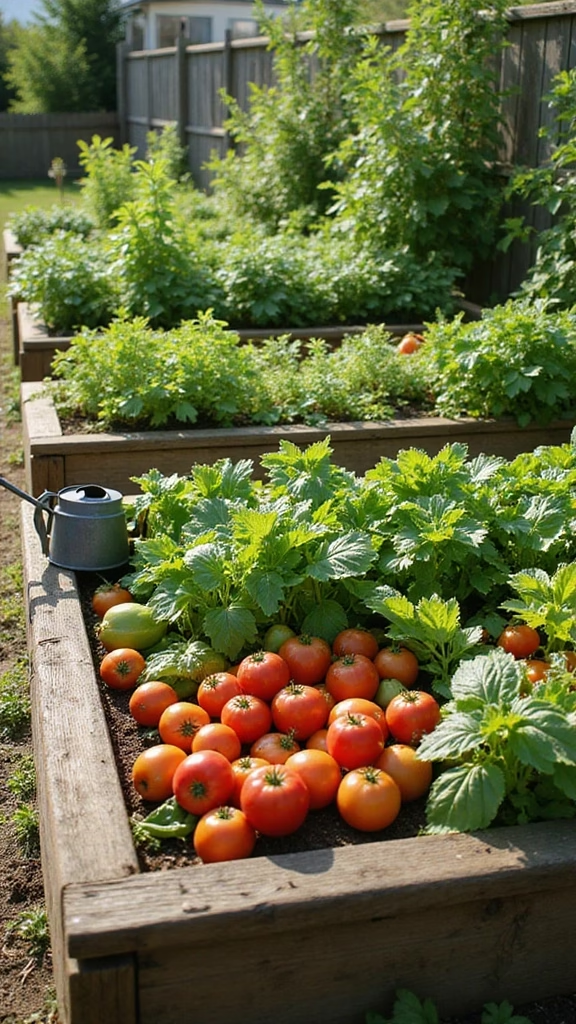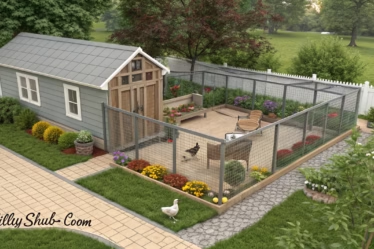
This Blog post is about Vegetable Garden Ideas
Transform your outdoor space into a vibrant vegetable garden that not only beautifies your home but also promotes healthy eating.
Discover innovative gardening ideas that enable you to cultivate fresh vegetables right in your backyard.
From vertical gardens to companion planting, these strategies are perfect for maximizing space and optimizing your harvest, ensuring you enjoy garden-to-table meals full of flavor and nutrition.
1. Raised Garden Beds for Efficient Space Usage
Elevating your planting area with raised garden beds not only enhances the aesthetic appeal of your vegetable garden but also significantly improves drainage and soil quality. By utilizing a wooden raised garden bed kit, you can create defined spaces that facilitate organization and allow you to fill them with nutrient-rich organic soil mix tailored to the specific needs of your vegetables.
The added height of these beds minimizes strain on your back, making the gardening experience not only more enjoyable but also more accessible. Enhance your planting process further with vegetable plant markers to keep track of your diverse crops, and don’t forget to arm yourself with a sturdy garden trowel for efficient planting and maintenance.
Consider building multiple raised beds to create a vibrant patchwork of colors and varieties, ensuring a bountiful and diverse harvest throughout the growing season.
2. Vertical Gardening for Limited Spaces
Maximize your gardening potential, even in the most confined spaces, by embracing vertical gardening techniques.
By using a trellis for climbing plants, wall planters, or repurposed pallets, you can cultivate climbing vegetables like cucumbers and tomatoes, freeing up valuable ground space for other crops.
Not only do vertical gardens add a stunning visual element to your environment, but they also improve airflow and diminish the risk of disease among your plants.
To support your plants’ growth, consider incorporating organic fertilizer for optimal nutrition, and keep your garden tidy and well-maintained with gardening scissors.
This innovative approach allows you to create a mini-urban garden right on your balcony or patio, making healthy eating accessible and enjoyable for everyone.
3. Companion Planting for Natural Pest Control
Companion planting is a time-tested gardening strategy that involves pairing specific plants to enhance their growth while naturally repelling pests. For example, when you plant marigolds alongside tomatoes, they help deter nematodes and other harmful insects, while also attracting beneficial pollinators to your garden.
To get started, consider using a comprehensive companion planting guidebook that outlines the best plant combinations for your specific garden. This can help you create a flourishing ecosystem where plants support one another.
Additionally, supplement your garden with organic seeds that pair well together. For added protection against unwanted pests, a pest repellent spray can be a great tool to keep your crops safe. Lastly, ensure you have the right tools for planting and maintenance; a sturdy gardening hoe can make all the difference in cultivating a healthy vegetable garden. Embrace the art of companion planting to not only protect your crops but also boost your vegetable yields!
4. Herb Spiral Garden for Culinary Delights
Transform your outdoor space with a beautiful herb spiral garden that not only conserves space but also supplies a bountiful selection of fresh herbs for your culinary adventures.
The spiral design creates diverse micro-climates, making it ideal for growing a variety of herbs that prefer different soil conditions and moisture levels. Imagine having fresh basil, thyme, rosemary, and mint readily available to elevate your dishes with lively flavors.
To kickstart your project, consider using a herb spiral building kit for easy assembly. Pair this with organic herb seeds to ensure your garden is filled with vibrant, healthy plants.
To maintain optimal growing conditions, a soil moisture meter can help you monitor the hydration levels of your plants, while a charming garden watering can makes it easy to tend to your herbs.
This unique garden structure not only serves a practical purpose but also acts as a stunning focal point in your backyard, seamlessly combining beauty with functionality.
5. Container Gardening for Versatile Options
Container gardening opens up a world of possibilities for cultivating vegetables in almost any setting, whether it’s a cozy patio, a spacious balcony, or even a sunny windowsill.
Opt for decorative plant pots to create an eye-catching display, allowing you to plant a variety of vegetables such as peppers, lettuce, and fresh herbs.
This method not only enhances the aesthetics of your space but also provides the flexibility to easily move your plants around to capture optimal sunlight throughout the day.
To ensure your plants thrive, consider using a high-quality potting mix that supports healthy growth. For the best results, start with organic vegetable seeds that will yield delicious harvests.
And don’t forget to keep your plants hydrated with a stylish watering can, making your gardening experience both functional and enjoyable!
6. Square Foot Gardening for Maximized Yields
Square foot gardening is an innovative technique that enables you to maximize your vegetable yields within a compact space by dividing your garden into manageable square foot sections. Each square can be planted with a variety of vegetables, ensuring optimal spacing and growth conditions for each type.
To get started, consider investing in a square foot gardening kit, which provides all the essentials you need to set up your garden efficiently. Pair your gardening efforts with high-quality organic vegetable seeds to ensure a bountiful harvest.
Don’t forget to protect your hands while you work by using durable gardening gloves, making the planting process both safe and enjoyable. Finally, enhance your soil quality with raised bed soil, which provides the ideal nutrient-rich environment for your plants to thrive.
This method not only promotes efficient use of space but also presents a visually appealing layout that is easy to maintain, making it perfect for novice gardeners and anyone looking to cultivate a diverse garden while minimizing weeds and pests.
7. Edible Landscaping for Aesthetic Appeal
Transform your garden into a stunning and productive oasis by embracing the concept of edible landscaping, where ornamental plants and delicious vegetables coexist beautifully.
Imagine the vibrant hues of kale intermingled with an array of colorful flowers, crafting a visually captivating garden that appeals to all the senses. This approach not only elevates the aesthetic charm of your outdoor space but also promotes healthy eating straight from your landscape.
To get started, consider picking up an edible landscaping guidebook that provides inspiration and tips for designing your own edible paradise.
Enhance your garden’s variety and health by planting organic seeds that will flourish alongside your decorative blooms.
Don’t forget to showcase your plants in beautiful decorative plant pots, which can add an extra layer of charm and style to your landscape.
Finally, equip yourself with quality gardening tools to make the process of nurturing your edible garden easier and more enjoyable. By selecting a variety of textures and colors, you can create a feast for both the eyes and the palate.
8. Hydroponic Gardening for Year-Round Growth
Hydroponic gardening presents a revolutionary approach to growing vegetables without soil, making it possible to cultivate fresh produce all year round, regardless of external climate conditions.
This method utilizes nutrient-rich water, allowing plants to absorb essential nutrients directly through their roots, which can lead to quicker growth and higher yields.
Whether you’re interested in growing crisp lettuce or sweet strawberries, hydroponics is an ideal solution for urban gardeners seeking to maximize their space.
To get started, consider investing in a hydroponic gardening kit, which provides all the essential components for your indoor garden.
Ensure your plants thrive by using a quality nutrient solution that delivers the right balance of minerals.
Additionally, a reliable pH tester can help you monitor the acidity of your water, ensuring optimal conditions for your plants.
With these tools, you can enjoy a continuous harvest of fresh vegetables, even during the coldest months of the year!
9. Community Gardens for Shared Healthy Eating
Community gardens offer a fantastic opportunity to build connections with your neighbors while championing healthy eating and sustainable practices.
These collaborative spaces enable individuals to grow vegetables together, fostering a strong sense of community and teamwork. As you work side by side, you can learn valuable gardening techniques from one another, share resources, and relish the rewards of your collective efforts.
To enhance your experience, consider investing in a comprehensive community gardening guidebook, which can provide insights and tips for successful gardening. Additionally, having the right gardening tools will make your gardening tasks easier and more enjoyable.
Whether you join an existing community garden or start one in your area, you’ll not only cultivate fresh produce but also create lasting friendships with fellow garden enthusiasts.
10. Seasonal Gardening for Year-Round Harvest
Embrace the beauty of seasonal gardening by strategically planning your vegetable garden around the changing seasons. This approach ensures a continuous harvest throughout the year, allowing you to enjoy fresh produce from spring peas to winter kale.
To help you stay organized and make the most of each season’s bounty, consider using a gardening calendar. This handy tool can assist you in tracking planting and harvesting times, ensuring you don’t miss a beat.
Additionally, investing in seasonal vegetable seed packets allows you to select the best crops for each season. As you cultivate your garden, protect your hands with a pair of durable gardening gloves, ensuring comfort while you work.
Finally, monitor your soil temperature with a soil thermometer to determine the perfect planting times for various vegetables. This method not only encourages healthy eating habits but also allows you to adapt your meals to include a variety of seasonal produce.
11. Straw Bale Gardening for Innovative Techniques
Straw bale gardening is an innovative technique that allows you to cultivate vegetables directly in bales of straw, making it an excellent choice for those dealing with poor soil conditions. As the bales decompose, they create a nutrient-rich environment that supports robust vegetable growth.
You can arrange the bales in various configurations to fit your garden layout, adding a unique and rustic charm to your outdoor space. This method not only ensures excellent drainage but also provides warmth, which is essential for promoting healthy growth across a variety of vegetables.
To get started, you’ll need some quality straw bales. Pair them with organic vegetable seeds for an eco-friendly gardening experience. Don’t forget to protect your hands with gardening gloves while you work, and consider using a compost accelerator to enhance the decomposition process and enrich the soil even further.
12. Perennial Vegetables for Low-Maintenance Gardens
Consider adding perennial vegetables to your garden to enjoy a low-maintenance approach that yields fresh produce year after year. Plants like asparagus, rhubarb, and artichokes thrive season after season, allowing you to savor delicious vegetables without the hassle of replanting.
To set yourself up for success, start with high-quality perennial vegetable seeds that will flourish in your garden. Once planted, the right gardening tools can make maintenance a breeze, ensuring your plants thrive with minimal effort.
Additionally, using organic mulch around your perennials can help retain moisture and suppress weeds, further reducing the amount of work needed. To optimize your soil’s health, consider testing it with a soil test kit to ensure your plants have the nutrients they need for robust growth.
By dedicating a specific area of your garden to these perennial vegetables, you’ll guarantee a consistent supply of fresh produce while enjoying the benefits of sustainable gardening.
Conclusion
Creating a vegetable garden in your backyard is not only a rewarding hobby but also a step towards healthier living and sustainable eating.
By implementing these diverse gardening ideas, you can cultivate a vibrant space that supports fresh produce and enhances your culinary experiences.
So gather your tools, get your hands in the soil, and start your journey towards a flourishing garden that brings joy and health right to your table.
Note: We aim to provide accurate product links, but some may occasionally expire or become unavailable. If this happens, please search directly on Amazon for the product or a suitable alternative.
This post contains Amazon affiliate links, meaning I may earn a small commission if you purchase through my links, at no extra cost to you.
















